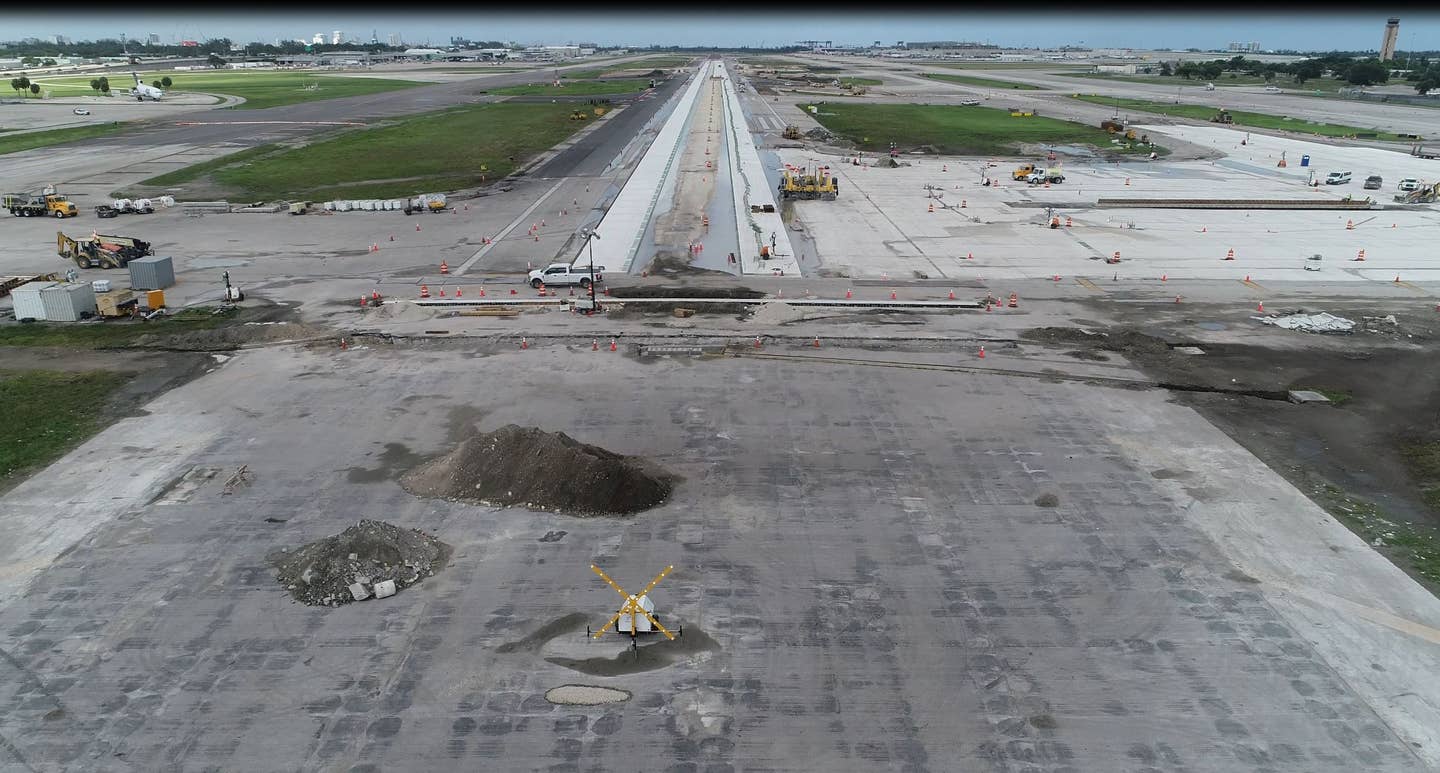DARPA Project Seeks Self-Healing Concrete for Infrastructure, Runway Repair
If successful, the strategy for repairing aging concrete by mimicking biological systems could extend the life of critical military airfields and runways.

Runway repairs, like the ones made in 2020 to the north runway at Fort Lauderdale-Hollywood International Airport (KFLL), can cost millions of dollars. DARPA’s project could lessen these costs. [File photo: Fort Lauderdale-Hollywood International Airport
Editor’s Note: This article is part of special series spotlighting runways: April 18: America’s Longest Runways | America’s Shortest Runways | April 19: 11 Fun Faces About Runways | April 20: Self-healing Concrete and How It Can Save Runways | April 21: Old Military Runways | April 22: Remembering Meigs Field
If a new Defense Department program is successful, cracks in aging concrete could one day fix themselves on the inside before their destruction reaches the surface, extending the lifespace of critical military infrastructure, such as runways and airfield pavement.
The Defense Advanced Research Projects Agency (DARPA) has solicited research proposals for its new Bio-inspired Restoration of Aged Concrete Edifices program, known as BRACE, that sets out to explore new technologies that could be used to self-heal concrete through vascularization, the agency announced late last month.
"The DOD has a lot of infrastructure that it relies on that was built in the mid 20th century or earlier, still in use today, it is likely to be in use for decades to come [and] is nearing or at the end of its design service life," BRACE program manager Dr. Matthew Pava told FLYING. "And yet these structures still retain strategic relevance."
Prolonged Repair Need
Concrete is the most widely used construction material in the world, with about three tons used for every person in the world annually, which makes rectifying structural concerns a top public concern, according to an engineering study.
For a military reliant on post-World-War-II-era infrastructure, crumbling concrete can lead to expensive repairs for mission-critical assets. Reconstruction of the 2-mile long, 80-year-old runway at Offutt Air Force Base in Nebraska is expected to take about 18 months and cost nearly $200 million, Omaha World-Herald reported last year.
"The idea here is that microorganisms, for instance, are but one possible strategy one might use."
Dr. Matthew Pava, BRACE Program Manager
The cracks that formed over the runway over decades of use aren't unique to the Nebraska airfield.
"Unfortunately, state-of-the-art approaches to maintain concrete are one-time interventions, limited to remediation of defects at or near the surface, and typically necessitate down-time for critical assets," DARPA's presolicitation said. "No current technology provides persistent crack repair and prevention for defects deep inside existing aged concrete or prolonged repair of damaged airfield pavements."
DARPA's BRACE program seeks to target the unique aspect of repairing critical DOD infrastructure, such as missile silos, naval piers, and runways in far-flung locations in an expeditionary setting, that are not feasible to replace on a short timeline, Pava said.
"This program is very much repair focused," he said. "We're looking to devise solutions that can be applied in the structural context to that existing concrete and inform vascular structures in that concrete to transport material that you need to heal defects, like cracks, for instance, that can emerge deep in concrete before propagating to the surface.
Reaching the problem is the primary challenge.
As concrete ages, it becomes more porous, which could provide an opportunity, Pava explained. A vascularization approach mimicking biological systems would act as a conveyor belt that has access to the surface of the concrete, where material could be moved from the outside to a crack that needs to be filled on the inside.
"The idea here is that microorganisms, for instance, are but one possible strategy one might use," Pava said. Microorganisms could be ideal because they are able to live in a wide variety of environments, including an alkaline environment, such as concrete. "Their size is a potential advantage in terms of navigating some of these small openings that would be anticipated to form in aged concrete material," he added.
Airfield Repairs
Logistics for making infrastructure repairs is also a top concern for the DARPA program.
"A lot of the cases, the airfields are located in kind of austere settings," Pava said. "They're hard to support logistically when you do need to do a repair and particularly in the event that your airfield has been attacked, and you have to restore [it]. It probably has craters in it. You have to restore that airfield surface as quickly as possible to resume operations."
Despite the military focus, the BRACE project could one day have utility in the civilian world.
"Hopefully, what we're doing on the program… is kind of de-risking the trajectory a little bit," Pava said. "If it's successful, then at the end of this, somebody can pick it up and there's a technology that's already been demonstrated in actual structures that they can then go on and continue to develop."
The goal of the program is to also buy time.
"Extending service life doesn't mean that we intend or expect that this program is going to yield solutions that make concrete impervious to deterioration, like until the end of time. That's probably not going to happen," Pava said. "But what we are looking to do is to extend the service life of structures into the future over a significant amount of time, over several decades.
“And should things need to be replaced over time, which you could imagine that they would, then that gives you a little bit of a longer runway to implement some of those replacements. Hopefully, you could do that in a more cost effective and environmentally friendly way, if you had that longer timeframe to do those repairs."
DARPA anticipates program research will begin by the end of the year.

Sign-up for newsletters & special offers!
Get the latest FLYING stories & special offers delivered directly to your inbox






